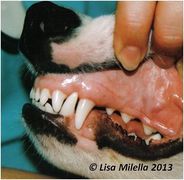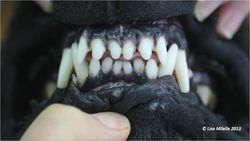Normal Dental Occlusion
Jump to navigation
Jump to search
The ideal occlusion can be described as the perfect interdigitation of the upper and lower teeth. In the normal dog, the ideal tooth positions in the arches are defined by the occlusal, inter-arch and interdental relationships of the teeth.
The ideal relationship with the mouth closed can be defined by the following:
- Maxillary incisor teeth all positioned rostral to the corresponding mandibular incisor teeth.
- Mandibular canine tooth is inclined labially and bisects the interproximal space between the opposing maxillary third incisor tooth and canine tooth.
- Maxillary premolar teeth do not contact the mandibular premolar teeth.
- The mesial crown cusp of the maxillary fourth premolar tooth is positioned lateral to the space between the mandibular fourth premolar tooth and the mandibular first molar tooth.
This is described as orthocclusion.
The length of a dog's jaw is most importantly determined by its genetic background. Problems exist commonly in dogs mainly due to the great variation in skull types within the species. Other factors can influence jaw length during growth, such as diet, metabolism, trauma, infection and forces within the mouth.

